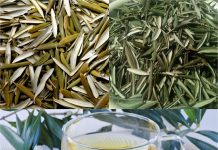Oil stains on kitchen walls can be a persistent nuisance, often resisting conventional cleaning methods and leaving behind unsightly marks. Whether it’s splatters from cooking or residue buildup over time, these stains can detract from the appearance of your kitchen.
But fear not! With a few simple homemade solutions, you can bid farewell to those stubborn oil stains and restore your kitchen walls to their pristine condition. Let’s explore some effective techniques to remove oil stains using everyday ingredients found in your pantry.
Hot Vinegar Method: To begin, don your protective gloves to shield your hands during the cleaning process. Using absorbent paper, gently blot away any excess oil from the surface of the wall. This step is crucial as it helps to remove the superficial layer of oil, allowing the cleaning solution to penetrate deeper. Next, heat up 1-2 cups of white vinegar in a pot until it’s hot but not boiling. Vinegar is a natural degreaser and effectively breaks down oil stains. Dip a clean cloth into the hot vinegar and carefully wipe it over the oil stains on the wall. The acidity of the vinegar helps to emulsify the oil, making it easier to lift off the surface.
Be sure to work in small sections, focusing on one area at a time. Once you’ve wiped the affected area, rinse it thoroughly with hot water using another clean cloth. This step helps to remove any residual vinegar and loosened oil. Finally, dry the wall with a third clean cloth. For stubborn stains, you may need to repeat the process, but be cautious not to damage the paint with excessive use of vinegar.
Lemon Method: Another effective way to tackle oil stains is with the power of lemon. Start by squeezing the juice of one lemon into a container. Lemon juice contains citric acid, which acts as a natural bleaching agent and helps to break down grease and grime. Wet a cloth in the lemon juice and gently rub it over the oil stains for a few minutes.
You’ll notice the stains gradually lighten as the lemon juice works its magic. Lemon also leaves behind a fresh, citrusy scent, making it a pleasant alternative to harsh chemical cleaners. Once you’ve treated the area, finish by wiping it with a dry cloth to remove any excess lemon juice. Keep in mind that this method is most effective on white walls, as colored walls may risk discoloration from the acidic lemon juice.
Flour Method: For those particularly stubborn oil stains, the flour method can come to the rescue. Simply sprinkle a small amount of flour directly onto the stains and let it sit for about 30 minutes. The flour acts as an absorbent agent, drawing out the oil from the wall surface. As it sits, the flour absorbs the oil, making it easier to lift off. After the allotted time, use a hot damp cloth to wipe away the flour and oil residue. For extra stubborn stains, you can use a brush to gently scrub the area before wiping it clean with a cloth.
- Baking soda paste: Mix baking soda with water to form a paste and apply it to stubborn oil stains. Let it sit for a few minutes before scrubbing with a brush and wiping clean.
- Commercial degreasers: If homemade solutions don’t do the trick, consider using commercial degreasers specifically designed for kitchen surfaces. Follow the manufacturer’s instructions carefully and test in a small, inconspicuous area first.
- Preventive measures: To avoid future oil stains, consider installing a backsplash behind your stove or using splatter screens while cooking. Regularly wiping down walls with a mild detergent solution can also help prevent buildup.
Conclusion:
With these simple homemade solutions and additional tips, removing oil stains from kitchen walls is no longer a daunting task. Whether you opt for the hot vinegar method, the refreshing lemon method, or the absorbent flour method, you can banish those stubborn stains and restore the beauty of your kitchen walls. Say goodbye to unsightly marks and hello to a clean and pristine cooking space. For more useful tips and tricks, be sure to visit our website.
SOURCE OF THE PICTURE : homeremediesseasy










